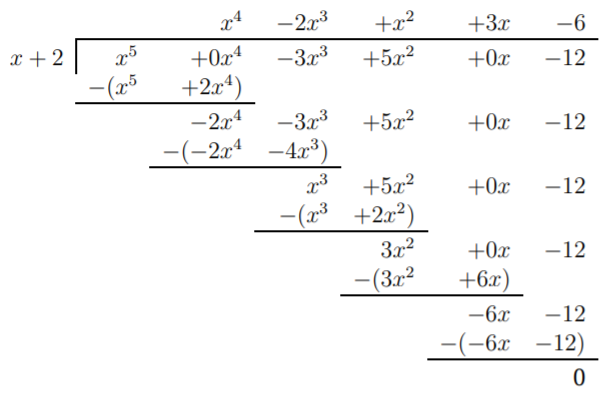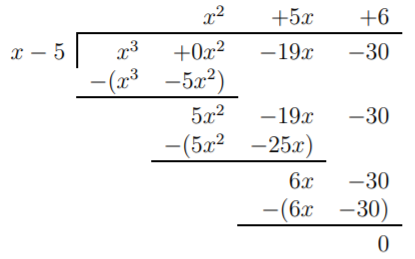8.2: Dividiendo por (x - c)
- Page ID
- 117725
Ahora restringimos nuestra atención al caso donde el divisor es\(g(x)=x-c\) para algún número real\(c\). En este caso, el resto\(r\) de la división\(f(x)\) por\(g(x)\) es un número real. Hacemos las siguientes observaciones.
Supongamos que\(g(x)=x-c\), y la larga división de\(f(x)\) por\(g(x)\) tiene resto\(r\), es decir,
\[\text{Assumption: } f(x)=q(x)\cdot (x-c)+r \nonumber \]
Cuando evaluamos ambos lados en la ecuación anterior en\(x=c\) vemos eso\(f(c)=q(c)\cdot (c-c)+r = q(c)\cdot 0 + r=r\). En resumen:
\[\boxed{\text{The remainder when dividing $f(x)$ by $(x-c)$ is } \quad r=f(c)}\]
En particular:
\[\boxed{f(c)=0 \quad \iff \quad g(x)=x-c \text{ is a factor of } f(x)}\]
La declaración anterior\(\PageIndex{1}\) se llama teorema del resto, y\(\PageIndex{2}\) se llama teorema del factor.
El resto al dividir\(f(x)\) por\((x-c)\) es\(r=f(c)\)
\(f(c)=0 \quad \iff \quad g(x)=x-c\)es un factor de\(f(x)\)
Encuentra el resto de dividir\(f(x)=x^2+3x+2\) por
- \(x-3\)
- \(x+4\)
- \(x+1\)
- \(x-\dfrac{1}{2}\)
Solución
Por Observación, sabemos que el resto\(r\) de la división por\(x-c\) es\(f(c)\).
- Así, el resto de la parte (a), al dividir por\(x-3\) es\[r=f(3)=3^2+3\cdot 3+2=9+9+2=20 \nonumber \]
- Para (b), tenga en cuenta que\(g(x)=x+4=x-(-4)\), para que tomemos\(c=-4\) por nuestro insumo dando eso\(r= f(-4)=(-4)^2+3\cdot (-4)+2=16-12+2=6\).
Del mismo modo, los demás restos son:
- \(r=f(-1)=(-1)^{2}+3 \cdot(-1)+2=1-3+2=0\)
- \(r=f\left(\dfrac{1}{2}\right)=\left(\dfrac{1}{2}\right)^{2}+\dfrac{1}{2} \cdot 3+2=\dfrac{1}{4}+\dfrac{3}{2}+2=\dfrac{1+6+8}{4}=\dfrac{15}{4}\)
Tenga en cuenta que en la parte (c), encontramos un resto\(0\), por lo que\((x+1)\) es un factor de\(f(x)\).
Determinar si\(g(x)\) es un factor de\(f(x)\).
- \(f(x)=x^3+2x^2+5x+1, \quad g(x)=x-2\)
- \(f(x)=x^4+4 x^3+x^2+18, \quad g(x)=x+3\)
- \(f(x)=x^5+3x^2+7, \quad g(x)=x+1\)
Solución
- Tenemos que determinar si\(2\) es una raíz de\(f(x)=x^3+2x^2+5x+1\), es decir, si\(f(2)\) es cero. \[f(2)=2^3+2\cdot 2^2+5\cdot 2+1=8+8+10+1=27 \nonumber \]Ya que\(f(2)=27\neq 0\), vemos que no\(g(x)=x-2\) es un factor de\(f(x)\).
- Ahora,\(g(x)=x+3=x-(-3)\), para que calculemos:\[f(-3)=(-3)^4+4\cdot (-3)^3+(-3)^2-18=81-108+9+18=0 \nonumber \] Dado que el resto es cero, vemos que\(x+3\) es un factor de\(x^4+4\cdot x^3+x^2+18\). Por lo tanto, si quisiéramos encontrar el otro factor, podríamos usar la división larga para obtener el cociente.
- Por último, tenemos: no\[f(-1)=(-1)^5+3\cdot (-1)^2+7=-1+3+7=9 \nonumber \]\(g(x)=x+1\) es un factor de\(f(x)=x^5+3x^2+7\).
- Demuestre que\(-2\) es una raíz de\(f(x)=x^5-3\cdot x^3+5x^2-12\), y use esto para factorizar\(f\).
- Demuestre que\(5\) es una raíz de\(f(x)=x^3-19x-30\), y use esto para factorizar\(f\) completamente.
Solución
- Primero, calculamos que\(-2\) es una raíz. \[f(-2)=(-2)^5-3\cdot (-2)^3+5\cdot (-2)^2+12=-32+24+20-12=0 \nonumber \]Así podemos dividirnos\(f(x)\) por\(g(x)=x-(-2)=x+2\):

Así que factorizamos\(f(x)\) como\(f(x)=(x^4-2x^3+x^2+3x-6)\cdot (x+2)\).
- Nuevamente empezamos calculando\(f(5)\): División\[f(5)=5^3-19\cdot 5-30=125-95-30=0 \nonumber \] larga por\(g(x)=x-5\) da:

Por lo tanto,\(x^3-19x-30=(x^2+5x+6)\cdot(x-5)\). Para factorizar\(f\) completamente, también factorizamos\(x^2+5x+6\). \[f(x)=(x^2+5x+6)\cdot(x-5)=(x+2)\cdot(x+3)\cdot(x-5) \nonumber \]


